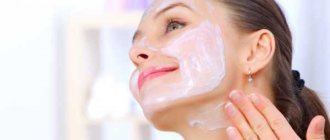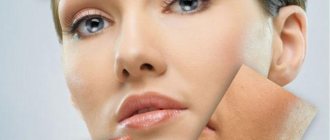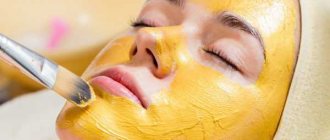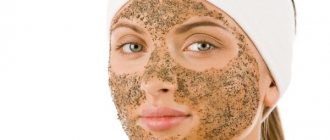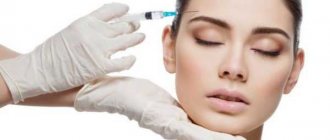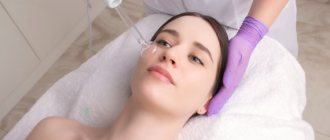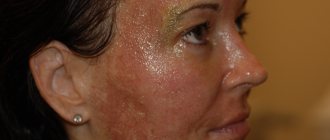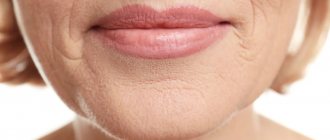Differences in chemical peels by depth of penetration
- Super-superficial (affect only the stratum corneum of the skin) is a comfortable method for improving the quality of all types of skin. For example, 10% TCA-trichloroacetic acid, salicylic acid, alpha (30% glycolic acid) and beta hydroxy acid (5% salicylic acid), 5-10% retinol, enzymes of plant and animal origin (papain, trypsin).
- Superficial (act on the upper layers of the epidermis without disturbing the basal layer) - safe, painless, quickly renew, moisturize the skin without injury and enhance the formation of collagen and elastin with the help of weak acids. For example, 15-20% TCA, 30-50% glycolic and 20% salicylic, fruit acids (lactic, tartaric, mandelic), resorcinol.
- Median (penetrate the entire thickness of the epidermis and dermis to the papillary layer within living structures). They have a moderate painful, pronounced rejuvenating effect, improve the structure of the skin, activate the synthesis of new cells, and provide long-lasting results due to high concentrations of active components. For example, 25-30% TCA, 70% glycolic acid, 30-40% salicylic acid, Jessner's solution, 50% fruit acids.
- Deep (captures the epidermis and the entire thickness of the dermis, leaving small “islands” of tissue for regeneration). Correct significant defects and restore cellular resources. They are rarely performed in a hospital setting using anesthesia due to severe pain and possible complications. For example, phenol preparations.
What happens to the skin after peeling
Peels are a kind of skin operation to remove dead cells, layers, and dirt particles embedded deep in the pores. Often the peeling procedure involves the complete removal of the surface layers of the epidermis with their further renewal.
After mechanical, hardware or chemical intervention, the skin is deprived of its previous protection, and the body’s forces are aimed at regeneration and restoration of lost tissue. Peeling is stressful for the skin, so to smooth it out and quickly strengthen the skin, competent, high-quality care is needed.
The severity and duration of the period of restoration of the integument depends on the depth and intensity of exposure to an acid composition, laser or other peeling agent:
- After superficial facial cleansing (for example, yellow peeling), the rehabilitation stage lasts from 3 to 7 days. The damage to the integument is minor, so its restoration does not take a long time.
- After a mid-peel, the situation is more complicated and full recovery will take up to 14 days.
- Deep peeling is the most difficult cleansing procedure. Its effect in some aspects is compared to surgery. The recovery process is long and requires frequent monitoring by a cosmetologist. The slightest deviation from prescribed care can cause complications. The rehabilitation period, at best, ends after 3 weeks, and at worst, it can last 3 months or more.
In most cases, after peeling, active peeling, crusting and redness are observed on the face. As a rule, by the end of the recovery period they finally disappear. However, this is not a reason to “curtail” proper facial care. The processes to restore the integument continue for another 1–2 months, but the risk of complications is significantly reduced.
Going to the bathhouse not only brings pleasure, but also heals the skin. Increased temperature and humidity contribute to the rapid opening of pores. These conditions stimulate increased work of the sebaceous glands, you sweat, and with sweat particles, toxins and harmful substances accumulated by epidermal cells leave the body.
Modern cosmetology welcomes the application of nourishing natural masks before a bath in order to ultimately increase their effectiveness. Or, on the contrary, applying medicinal cosmetics to a steamed and cleansed face, when the receptivity of the epidermis is high. However, cosmetology absolutely prohibits going to the bathhouse after undergoing peeling, regardless of whether it is yellow peeling or dermabrasion.
Please note that if you use masks or cosmetics before going to the bathhouse or sauna, make sure they are natural. Elevated temperatures promote the decomposition of chemical compounds and their rapid absorption by cells. The effect can be completely opposite.
What other prohibitions are there after peeling?
Cosmetologists unequivocally state that after any peeling it is prohibited to go to the bathhouse. To avoid complications in the period after peeling and to quickly restore the skin without residual scars, unsightly dark and light pigment spots, additional precautions concern:
- going to the pool - chlorine and can cause burns and excessive dryness of the skin, and there is also a high risk of infection of damaged fibers;
- ignoring sunscreen cosmetics - you need to apply creams with SPF filters every day, regardless of the weather outside, for 2-6 months after peeling. With increased solar activity, the highest protection index is used (SPF 50 and higher), and the number of applications is also increased. Otherwise, dark pigment spots appear on the face from daytime sunlight;
- visiting solariums and sunbathing - violation of this condition threatens hyperpigmentation of the integument, inflammatory processes, severe burns and even the development of oncology;
- playing sports - active, strength exercises and loads provoke increased sweating. This increases the risk of infection by sweat particles and wounds becoming suppurated several times.
Despite the fact that these restrictions apply to the rehabilitation period, you should refrain from visiting the pool, bathhouse or solarium for 1.5–2 months. This is the only way you will be able to achieve perfect skin without additional complications in the shortest possible time.
Each type of cleansing has its own subtleties. After some exfoliations, even any contact with water is not allowed, for example, deep exposure to phenolic acid. But the yellow peeling is washed off only 3-6 hours after application. Therefore, find out any terms and nuances in care from your cosmetologist.
Peeling causes significant changes inside the skin, enhances regeneration, but weakens its protection. Keep in mind the slightest mistake; wrong actions can cause great harm and lead to unpleasant consequences.
After peeling: restoration and skin care
A bath after peeling is one of the contraindications that must be taken into account in the post-procedure period. Despite the fact that systematic visits to the bathhouse or sauna are beneficial for the body, after peeling, being in conditions of elevated temperature harms the already weakened skin. Cosmetologists prohibit performing skin steaming procedures, including visiting a bathhouse after peeling of any type, chemical, retinoic, mechanical, etc. The reasons for this are as follows.
Women who go to the bathhouse after peeling make a grave mistake. Steaming is good for the skin and the body in general, but in the period after the cleansing procedure, visiting the steam room can provoke serious complications. Women should know how to care for their skin after salon cleaning. To understand why you should not visit the steam room after facial peeling, you need to understand how the cosmetic procedure affects the skin.
Peeling is a useful facial skin care procedure. But after this the surface becomes extremely vulnerable, so it needs special care. Poor behavior after the procedure can lead to serious side effects. Moisturizing masks will help avoid the formation of scars and scars and speed up healing.
In order to see your face looking young and radiant after peeling, you must adhere to certain skin care rules. As a rule, a cosmetologist gives a list of advice to a woman after the exfoliation procedure. These requirements are mandatory.
What to do if side effects occur?
Folk recipes for bath scrub, beneficial properties of abrasive cosmetics, possible contraindications to procedures, ingredients and their properties, rules for using bath scrub.
A bath scrub is an excellent skin care product that can enhance the cleansing effect of bath procedures, a mixture of several ingredients. Some are able to provide a massage and exfoliating effect on the skin, while others at the same time provide other beneficial effects, for example, additional nutrition of cells.
Representatives of the fairer sex try in every possible way to take care of their bodies, in an attempt to preserve beauty and youth. One of the effective and therefore quite popular methods is visiting a bathhouse. It is known that bath procedures not only make a person healthier and help resist many diseases, but also help improve the condition of the skin.
In a Russian bath, Finnish sauna, Turkish hammam or other type of steam room, the first thing that is exposed to the beneficial effects of heat is the skin. Metabolic processes are activated in it, pores are opened for improved oxygen supply and a path is opened for the release of decay products and the penetration of useful substances.
On the path to beauty, scrubs are an excellent assistant to thermal and water procedures. They play an important role in body care, because... are able to multiply the positive effect obtained from going to the bathhouse. It is noteworthy that the use of scrubs has a greater beneficial effect in a bathhouse than when used in ordinary home conditions.
Removing dead particles from the skin is the very first property of any scrub, i.e. its most important purpose. However, along with this, accompanying beneficial effects are also revealed, which largely depend on additional ingredients.
Let us describe the beneficial effects a scrub can have on the skin:
- Massage effect. Each scrub contains coarse particles, such as coffee, crushed apricot kernels, and salt. When distributed over the skin, they not only remove dead cells, but also involuntarily massage the upper layers, which further stimulates metabolic processes.
- Cleansing effect. Along with dead epidermal cells, any other contaminants are removed - dust, sweat. Through open pores, waste products of each epidermal cell are more actively removed.
- Smoothes the surface of the skin. Massage, cleansing and heat help remove excess fluid and make the skin smooth. On certain areas of the body surface (elbows, buttocks), goose bumps sometimes appear, which do not disappear in warmth, but are characterized by the formation of multiple pimples, often with a dry surface. It doesn't make your skin look beautiful at all. A scrub in combination with bath procedures will help get rid of such a defect not only with the help of the effects already described, but also thanks to additional nutrition with useful substances.
- Evens out skin tone. The inclusion of ingredients such as clay, parsley, lemon, etc. in the homemade scrub formula leads to the elimination of age spots and lightening of the upper layers of the epidermis.
- Skin cell renewal. Accelerated cellular metabolism allows cells to renew themselves even faster.
- Giving the skin firmness and elasticity. This result can be obtained by normalizing the process of collagen synthesis and the equally important elastin, which are responsible for the elasticity and firmness of the skin.
- Fight cellulite. Getting rid of orange peel is a consequence of long-term systematic visits to the bathhouse and the joint use of scrubs prepared from natural ingredients at home. The result is achieved thanks to a complex of beneficial properties of water-thermal procedures and scrub.
- Additional nutrition of the epidermis. A deep effect on the skin leads to more intense absorption of beneficial substances, the composition of which in each individually prepared scrub depends on the included ingredients.
In general, the beneficial effects of the scrub can be called rejuvenating and healing due to mechanical and chemical effects.
Going to the bathhouse itself may be contraindicated for some people due to their existing health problems. Most often, these contraindications are not a ban on using the scrub.
Let's look at the reasons why you should not use a scrub under any conditions:
- The presence of skin diseases characterized by purulent inflammation and open wounds is a direct contraindication.
- Thin, delicate skin can be easily damaged by rough particles of a caring cosmetic product, so you should avoid aggressive mechanical action or replace salt, crushed apricot kernels or nut shells with more gentle products, such as honey.
- Individual intolerance to at least one ingredient. This contraindication is conditional, because at home, it’s easy to decide for yourself what will be included in a homemade scrub, and thereby eliminate dangerous ingredients from the formula.
A bath scrub prepared at home can contain a wide variety of ingredients, which determine the result obtained. The choice of components should be made depending on the skin type, existing problems and the desired effect. The most important advantages of homemade exfoliating compositions are the natural composition and guaranteed freshness of the mixture, which is important for the absence of side effects.
Conventionally, complications after peeling are divided into 2 types: expected and unexpected:
- The appearance of the former is an absolutely normal phenomenon, while the latter indicates a malfunction in the body, as well as mistakes made during the procedure or during the recovery period.
- If unexpected complications occur, you must immediately contact a specialist.
This phenomenon usually occurs on the 3rd day after peeling and lasts approximately 7 to 10 days. The following rules will help speed up the process of getting rid of peeling:
- use non-carbonated mineral water for washing;
- regularly moisturize the skin;
- do not touch your face with dirty hands;
- treat the skin with restorative agents;
- stop using lotions, scrubs and tonics for the entire recovery period.
The following means accelerate the regeneration of the epidermis:
- "Retinol";
- "Bisabolol";
- "Panthenol";
- antioxidant serums with vitamins C and E;
- creams containing hyaluronic acid or plant extracts;
- soothing gels and hydrogel masks.
The use of these products helps to quickly get rid of peeling.
A reaction to the cleaning procedure, in the form of swelling, appears a few days after it is carried out. As a rule, a similar effect is observed after yellow (retinoic) peeling using trichloroacetic acid. To prevent the appearance of edema, you need to correctly select the concentration of acidic agents for the procedure.
Redness after peeling is considered normal and usually goes away a few days after the procedure. To speed up this process, it is recommended to follow several rules:
- proper skin care;
- proper nutrition, including avoidance of carbonated drinks, as well as fatty, sweet and salty foods;
- drinking up to 3 liters of drinking water per day;
- use only hypoallergenic cosmetics.
Important! To eliminate redness, it is recommended to use only hypoallergenic cosmetics and avoid using powder and foundation.
A reaction to the cleaning procedure, in the form of swelling, appears a few days after it is carried out. As a rule, a similar effect is observed after yellow (retinoic) peeling using trichloroacetic acid. To prevent the appearance of edema, you need to correctly select the concentration of acidic agents for the procedure.
Carbon peeling: a modern method for solving cosmetic problems
Clients' problems do not change from year to year - unhealthy complexion, acne and its consequences, pigment spots, signs of aging and others. Only the methods of combating these phenomena change. One of the modern and technologically advanced procedures is carbon peeling. Now she is at the peak of popularity. If you have not yet managed to add it to your list of services, then this article will be of interest to you.
What is the essence of the method?
Carbon peeling is a procedure for cleansing the skin and renewing the skin. To carry it out, a nano-gel based on carbon dioxide and exposure to a neodymium laser are used.
During the procedure, the entire stratum corneum of the epidermis is affected.
Carbon nano-gel is a carbon amplifier, a kind of catalyst for further laser exposure. The gel pulls out impurities and sebaceous plugs from the skin. It also has a pronounced bactericidal effect.
Under the influence of laser radiation, carbon nano-gel penetrates into the deep layers of the skin, heats up and literally explodes. This way the skin is deeply cleansed and the production of elastin and collagen is stimulated.
Benefits of carbon peeling:
- Painless
- No side effects typical for other types of laser manipulation (swelling, redness, hematomas)
- No seasonal restrictions
- Complex effect - cleanses, heals, evens out skin texture and tone.
- The result is noticeable after the first procedure
- Suitable for almost everyone
Indications for carbon peeling
Carbon peeling can be carried out both for the purpose of preventive skin care and to solve various problems:
- Hyperpigmentation
- Enlarged pores
- Acne
- Increased sebum production
- Post-acne (scars after acne treatment, post-inflammatory spots)
- Aging skin, photoaging
- Dull skin
Most often, carbon peeling is used as an independent procedure. But it can also be carried out as a preparation for other procedures, for example, elos rejuvenation or acne therapy.
How is carbon peeling performed?
First, the cosmetologist talks with the client. Find out about the presence of contraindications. Inspects the problem area. Only after examination and history collection does the cosmetologist begin the procedure itself.
First stage
— cleansing the skin of cosmetics and impurities. It is very important to treat the skin with an antiseptic to reduce the risk of infection. Then nano-gel is applied to the skin. It should dry, this will take about 5-10 minutes.
An important point is that the gel must be applied with rubbing movements, in a thin layer. If there is a thick layer of gel, it will make it difficult for laser radiation to penetrate deep into the skin. And the procedure will not be as effective.
Carbon gel penetrates into the deep layers of the skin and accelerates the process of skin cleansing and cell exfoliation.
At the second stage
laser exposure occurs. The procedure itself is painless, the client feels a slight tingling sensation. A click is heard during each flash. It is better to warn the client about this in advance so that it does not scare him.
During the procedure, the skin is warmed up under the influence of infrared light. As a result, the process of cell regeneration is enhanced, the production of collagen and elastin, as well as hyaluronic acid, a natural skin moisturizer, is stimulated.
The procedure lasts about 30-40 minutes.
It is recommended to do carbon peeling in a course of 5-10 procedures with an interval of 7-14 days.
Recommendations after carbon peeling
In the first 10-15 minutes after peeling, the skin will be red. The redness goes away within 15 minutes to a day. Immediately after the procedure, you can return to your usual activities.
To prevent complications and side effects, you must follow the recommendations of cosmetologists:
- Avoid using decorative cosmetics for 1 day after the procedure
- Wash with soft foam for 14 days after peeling
- Do not use scrubs, peelings, products with coarse particles (salt, ground bones) for 14 days
- Use moisturizer to prevent skin dehydration
- Apply cream with provitamin B5 to the skin for 2 days after peeling to prevent dryness and irritation.
- It is prohibited to use alcohol-containing products for 7-10 days after the procedure
- You cannot visit the sauna or bathhouse for 14 days
- You cannot sunbathe or visit a solarium for 14 days.
- In sunny weather, use creams with a high degree of protection
Effect of carbon peeling
Carbon peeling has a complex effect and can solve many skin problems. Let's look at how it works and how the peeling effect appears.
- Exfoliates the top layer of skin. Thanks to this, the complexion is evened out, the skin becomes smoother, the water balance of the skin is restored, and peeling disappears.
- The production of elastin and collagen, which are responsible for the firmness and elasticity of the skin, is stimulated. Due to this, the skin becomes more taut and elastic. There are fewer fine expression wrinkles.
- Destroys bacteria. This helps fight acne and post-acne.
- Helps cleanse pores and eliminate open and closed comedones.
- By exfoliating horny scales soaked in melanin, hyperpigmentation is eliminated over time.
- Normalizes the secretion of the sebaceous glands. This allows you to eliminate oily shine.
Contraindications for carbon peeling
Carbon peeling has some contraindications that must be taken into account when signing up for the procedure. This is why it is necessary to first consult with the client. Carrying out the procedure in the presence of contraindications may lead to a deterioration in the client’s health.
List of contraindications
which the client must be familiarized with before the procedure:
- Oncological diseases
- Epilepsy
- Mental disorders
- Pregnancy and lactation
- Skin diseases in the acute stage
- Keloid scars in the treatment area
- Diabetes mellitus (insulin dependent)
- Vitiligo
- Colds accompanied by fever
- Allergy to carbon dioxide
- Photodermatitis
If there are microtraumas, abrasions, or herpes at the treatment site, then it is necessary to reschedule the procedure until the skin heals.
Carbon peeling is an effective procedure for rejuvenating and cleansing the skin. It is often called the “Hollywood Purge.” After 1-2 procedures, the result is noticeable - the skin becomes smoother and tighter. Immediately after peeling, you can return to your business, go to work, etc.
Carbon peeling has gained such popularity due to its painlessness and the absence of a recovery period in comparison with other types of laser therapy.
Is it possible to go to the bathhouse after peeling?
Peeling is a professional cosmetic procedure that is aimed at deep cleansing the skin of impurities, dead skin cells of the epidermis, and even eliminating fine wrinkles. The purpose of peeling may be different, since there are a great many of them, but the precautions for skin care are the same or very similar. How to care for your facial skin after peeling and what you should never do? Peeling always leads to remarkable visible changes, but if you neglect the rules that every cosmetologist must tell you before the procedure, not only may there be no effect, but the skin condition may even worsen. After exposure to chemicals, lasers or special devices, the skin becomes extremely vulnerable.
As you can see, the consequences of facial peeling can be different.
Why is it forbidden to visit the bathhouse after
Cosmetologists prohibit performing skin steaming procedures, including visiting a bathhouse after any type of peeling (chemical, retinoic, mechanical, etc.). The reasons for this are as follows.
Such factors create favorable conditions for the entry, development and activity of harmful microorganisms. In addition, the skin can become infected due to increased sweating. Sweat gets onto the post-peeling wound, thereby causing irritation and sometimes a purulent process.
After the procedure, any thermal exposure is not recommended. This can lead to various consequences.
Therefore, it is necessary to follow all recommendations given by the cosmetologist.
Slowing down the regeneration process of injured epidermis
This can be explained by increased air humidity, which causes deterioration and softening of the surface layer of the dermis.
Development of rosacea
Complications arise due to exposure to high temperature. As a result, subcutaneous hemorrhages, bruises, persistent erythema, and swelling occur.
Getting an even bigger burn
If acids are used during the procedure, its particles remain inside the dermis even after peeling. Under the influence of elevated temperature, they are activated, which provokes a repeated effect on weakened tissues. As a result, an extensive burn of the dermis is formed, and an allergic reaction develops.
Cosmetologists do not recommend visiting a bathhouse after peeling.
This is due to the vulnerability of the skin during this period, which increases the risk of infection, a slowdown in the regeneration process due to high humidity and increased post-procedure burns.
To summarize, it can be noted that a bath after superficial or deep peeling is not only harmful, but also dangerous, as it causes serious visible defects.
Possible consequences
It is unacceptable to visit the bathhouse after peeling, as the following complications may occur:
- Skin infection. High temperature and humidity are ideal conditions for the growth of bacteria. In a public bath complex, it is easy to pick up an infection if the skin is in a post-stress state and lacks protection. And it will take a long time to treat an infectious disease.
- Oxidation of skin tissue under the influence of steam. Because of this, the healing process is delayed, scars may remain, and pigment formations may appear.
- Cuperosis. Under the influence of hot air, the capillaries expand and blood flow increases. When the skin is weakened, it provokes fragility of blood vessels, the appearance of hematomas, bruises, and swelling.
- Skin irritation. After cleaning, a certain amount of chemicals remains in the skin pores, which have a beneficial effect on the tissue. But under the influence of temperature, these compounds begin to break down, turn into toxins, and when they penetrate microcracks, they cause inflammation and suppuration. Visiting the steam room after chemical peeling is especially dangerous: acid particles remaining in the skin tissue provoke severe allergic reactions and chemical burns.
- Irritant effects of salt. The salt that comes out of the pores in sweat is no less aggressive than chemicals.
How long after peeling can you not go to the bathhouse?
After exfoliation in the salon, the cosmetologist gives the client a number of recommendations about whether after peeling it is possible to go to the bathhouse or to the gym, which cosmetics are best to use, how to care for the face, and others. How conscientiously these tips are followed will directly determine how well the effect will manifest itself and how long it will last. There is a general list of recommendations from beauty salon masters for clients who have undergone an exfoliation procedure. But to this list of tips, items specific to different types of exfoliation will definitely be added. The more the skin is injured, the longer and more carefully it will need to be cared for. A woman’s body characteristics play a major role in the duration of rehabilitation: age, skin type, general condition of the body, metabolic characteristics.
Bath or sauna for healthy skin
If you do not take into account the recovery period after peeling, going to the bathhouse is good for the skin and the whole body. While in the steam room:
- under the influence of high temperature and steam, pores open, sweat output increases;
- skin with open pores is easily cleaned of dirt and sebaceous accumulations;
- with excessive sweating, toxins come out of the skin tissues;
- regeneration processes in tissues are accelerated;
- swelling subsides;
- Steamed skin actively absorbs beneficial substances from masks and cosmetics.
However, the bathhouse becomes dangerous if you go to it after peeling. Subsequently, any type of salon cleaning is prohibited from exposing the skin to thermal effects in high humidity conditions. It is especially dangerous to visit a bath complex of any type (including sauna, hammam, ofuro) within 2-3 days after the procedure.
Expert opinion
Anastasia Zaslavskaya
Dermatologist, cosmetologist
In the steam room, body temperature rises and sweat production increases. From the opened pores, along with moisture, the active substances contained in the preparations used for salon peeling come out. Because of this, the skin becomes irritated and the effectiveness of the peeling is reduced.
Also, one of the reasons why you should not visit a bathhouse during the rehabilitation period is the expansion of capillaries penetrating the skin tissue under the influence of high temperature and humidity. As a result, the skin turns red, and the process of subsidence of post-procedure hyperemia is delayed.
Important steps in post-peeling care
The chemical peeling procedure does not end at the beauty salon. After a visit to a cosmetologist, the skin faces a complex and painstaking recovery process, and even complications are possible.
.
Surface
Superficial exfoliation is the most gentle. Injury to the skin is minimal. Despite the relative safety of the procedure, the epidermis requires restoration. When can I take a steam bath after retinoic peeling? Elevated temperature and humidity are aggressive factors that can harm injured skin and slow down its recovery.
After superficial peeling, visiting the bathhouse is contraindicated until complete rehabilitation. As a rule, it takes no more than 2 weeks. In addition, the cosmetologist reminds clients that it is strictly forbidden to use exfoliating scrubs, chemical compounds or physical exfoliation methods after facial peeling.
A day after superficial exposure, you can use your usual brand of cosmetics, supplementing it with wound-healing and anti-inflammatory agents. It is necessary to moisturize the epidermis as often as possible and drink up to 2 liters of water daily.
Median
Medium peeling injures the deeper layers of the epidermis and recovery takes a long period of time. Facial care during the rehabilitation process should be delicate and thorough. To the cosmetologist’s question, “Can I go to the bathhouse after a medium-type chemical peel?” you will receive a negative answer.
Until the epidermis is restored layer by layer, all stress factors should be excluded: direct sunlight, high and low air temperatures, spicy foods, alcohol, harsh cosmetics, mechanical irritants.
Skin care should be done using mild cosmetics. You can wash your face only once a day with warm water. Therefore, you should temporarily exclude decorative cosmetics. If swelling and other side effects occur, you should consult a cosmetologist or dermatologist. You cannot self-medicate. All medications used must be prescribed only by a doctor. Deep
During the process of deep exfoliation, the skin suffers serious trauma. A woman is often in a hospital setting, where specialists monitor her health. After this, the cosmetologist gives a number of special recommendations: what to do after facial peeling and what not to do.
The following rules should be followed:
For a long period of up to two months, exfoliated skin should not be exposed to harmful factors. That’s why you can’t go to the bathhouse, play sports, or use a scrub after peeling.
Recommendations from cosmetologists
- Is it possible to apply foundation after peeling? - No you can not. This risks skin infection. In addition, the foundation will not cover up severe peeling, but, on the contrary, will emphasize them even more.
- How to quickly remove facial redness? – For 1.5 – 2 weeks you should give up spicy and fatty foods, alcohol consumption, sports activities and visiting the sauna. These actions dilate the blood vessels, so the redness goes away much more slowly.
- Is it possible to remove peeling on your own? – Under no circumstances should you solve the problem of facial peeling on your own. Additional abrasives to speed up the renewal process are prohibited. They can penetrate into the deep layers of the skin, causing scars that will be very difficult to remove.
- If you have the slightest suspicion of complications, you must immediately make an appointment with a cosmetologist. There is no need to wait for the problem to go away on its own. It often happens that a complication goes into a chronic stage without timely intervention.
Peeling helps renew the skin, filling it with health and radiance. At the same time, the procedure is quite complex, as it affects the deep layers of the epidermis.
Therefore, during the recovery period you need to be extremely careful and careful. You should always follow the recommendations given by a cosmetologist
Do not overuse cosmetics or self-medicate. Peeling is a complex procedure, which means its negative consequences can become irreversible.
General recommendations from cosmetologists
At the end of the exfoliation procedure, women have hundreds of questions swarming in their heads: from “Can I wash my face after peeling?” to “When will it be possible to go outside?” The salon master will definitely give a number of tips to consolidate the results of the impact and avoid negative consequences.
There are general recommendations after peeling from cosmetologists that are considered universal. They are relevant after exfoliation of any type and depth.
During the first 12 hours after the procedure:
What not to do in the first 48-72 hours after a chemical peel:
The rehabilitation period will continue for the next 2 weeks. At this time, the skin will peel and peel off after the procedure. In its place, new young cells are formed, which will form a refreshed face. To ensure a successful recovery, it is better to adhere to the following tips:
Many women are interested in the question: “How to exfoliate crusts after peeling?” Cosmetologists strictly prohibit tearing off skin flakes and removing them with scrubs. These crusts should come off on their own. Trauma to the skin can lead to the formation of scars.
Facial and body beauty treatments
Using brooms and steaming in a steam room are not the only activities that will help make a visit to the bathhouse beneficial for beauty. However, for the effect to be noticeable, you must wash thoroughly before entering the steam room. Dirt, sebum and cream residues will prevent the penetration of beneficial substances and the release of impurities and toxins.
Water
After steaming in the sauna, the body needs to be toned and cooled. Water procedures are necessary. As a rule, the following manipulations are carried out: dipping into a cold pool or font, dousing with ice water, rubbing, gommage, scrubbing.
Contrast water procedures have the following beneficial effects on the body:
- tone the body;
- strengthen the walls of blood vessels;
- hydromassage will help remove waste and toxins;
- accelerate the breakdown of fat deposits;
- even out skin texture;
- get rid of cellulite;
- relieve swelling.
After the steam room in the bathhouse, you must wash thoroughly with a washcloth. During steaming, the pores open and all toxins come out, so a shower helps get rid of them. It is also useful to apply a special scrub or exfoliant to the skin after steaming. Coffee or honey-salt has worked well. The skin will become soft, velvety, and even if there were blackheads and comedones, after the bath they become much less noticeable.
Wellness
In addition to cleansing, the bath also has healing properties. Health-improving procedures include hardening, warming, steaming, and aromatherapy.
The first means following the pattern: warming-cooling-relaxing. Each stage should last 10 - 15 minutes. However, it is still worth focusing on the well-being and experience of the person himself. You can start with 3 - 4 minutes, gradually increasing the time. After steaming in the steam room, you need to plunge into a cold pool or take a contrast shower, and then relax there for 10 minutes, drink tea or herbal infusions.
Such visits should be made up to 5 - 7 times. But you should not expect results from the first visit to the bathhouse; this procedure is cumulative.
For a cold accompanied by a cough and runny nose, you can resort to steaming in an aromatherapy bath. Essential oils of conifers, for example, fir, pine, eucalyptus, are added to the water for adding to the coals. It is important to breathe through your mouth, not your nose.
To further influence the nasopharynx, it is recommended to rub natural honey into the neck and chest after 5 - 10 minutes of steaming. However, it is important to avoid the area where the heart is located. Then take a warm shower and wash off the remaining honey.
The bath helps well with various diseases of the joints and musculoskeletal system. Before the steam room, you need to wash yourself thoroughly, then steam well and massage the painful areas. You can treat the areas with birch, nettle, juniper brooms, and apply regular medicinal ointments.
The bath is also indicated for acne and comedones. Linden leaves and a broom will help get rid of acne; you need to massage and rub the affected areas with them. During one visit to the bathhouse, it is necessary to make several visits, resorting to contrasting procedures. After just a few visits, you can notice a reduction in acne.
Scrub after chemical peeling
If superficial chemical peeling was carried out, then the scrub after the procedure can be used literally for 3-5 days. But such a product should have a minimum of abrasive particles, and after using it, the facial skin is immediately wiped with lotion/tonic and lubricated with moisturizer.
If a medium or deep chemical peel has been performed, then it is strictly forbidden to use scrubs until the skin is completely restored. In the future, there are no special features in carrying out procedures with this product.
Masks after chemical peeling at home
After chemical peeling, you can and should use masks that are prepared at home - they soothe irritated skin, promote its hydration, which causes rapid exfoliation of epidermal particles and healing of the surface.
You can avoid using complex recipes and simply treat your face with cosmetic oils - for example, from grape seeds, peach, almond. It would be optimal to spray them over the surface in order to comply with the cosmetologist’s recommendations regarding avoiding contact of fingers with the face.
Alginate
To prepare an alginate mask at home, you only need alginate mixture powder (sold in pharmacies or specialty stores) and still mineral water. You need to prepare a mixture that visually resembles a thin cream. It is applied to a previously cleansed face (after chemical peeling, it is simply wiped with lotion without alcohol in the composition) and left for 20 minutes, after which it is removed and the skin is wiped with a light, soft tonic.
Alginant mask:
- moisturizes,
- accelerates the exfoliation of epidermal particles,
- relieves swelling, redness,
- accelerates regeneration.
Calming
To relieve discomfort after chemical peeling, you should use a soothing mask based on milk, honey, egg yolks and aloe pulp/juice. The following combinations are suitable:
- 1 tablespoon milk + 1 tablespoon honey + 1 chicken yolk,
- 1 teaspoon oatmeal + 2 tablespoons milk + 1 teaspoon honey + 5 drops aloe juice.
You can start using such products from the 3rd day after the manipulation, provided that the cosmetologist has given permission to do so.
Chemical peeling of the face: the achieved effect and indications for use
Chemical peeling
activates the body's protective functions, resulting in increased production of substances such as hyaluronic acid, collagen and elastin. This leads to improved skin tone, getting rid of unevenness, and smoothing out wrinkles. The procedure of chemical peeling of the face will also save you from skin pigmentation, including age-related skin, scars and marks left by acne.
Most often, chemical peeling of the facial skin is performed, but this method is often used to care for such parts of the body as the neck, hands, and décolleté.
Indications for chemical peeling
- Chemical peeling of the face is needed to combat age-related changes in the skin.
- Chemical peeling of the face is effective regardless of age and skin characteristics. The only difference will be the composition of the acids used and their concentration.
But you should not resort to chemical peeling in the fight against a number of age-related skin changes, which include loss of elasticity and sagging. In this case, chemical peeling will not work; it is better to resort to the services of plastic surgeons and get a facelift.
results
The uses of chemical peeling are:
- Removing dead particles (skin smoothing, removing age spots),
- Increasing the immunity of epidermal cells (improving the protective barrier),
- Moisturizing (filling with hyaluronic acid),
- Rejuvenating effect and destruction of scars and stretch marks (collagen production),
- Facial skin lifting (elastin production),
- Elimination of inflammation (activation of skin cells).
What is the effect of the peeling procedure?
A chemical facial peel can renew and rejuvenate your skin. When pigmentation needs to be removed, some skin blemishes such as scars and acne marks resort to this procedure. After undergoing several sessions of chemical peeling, you can get rid of wrinkles, the effects of acne, and achieve narrowing of pores and a fresh complexion.
The peeling procedure can be applied to various parts of the body, not just the face. For example, chemical peeling is used on the back to get rid of pigmentation, pimples, and the effects of acne.
Recommended articles on the topic:
- Facial mesotherapy procedure: pros and cons
- Beauty injections: types of drugs, reviews
- Placental therapy is the secret of eternal youth
At what age can you have a chemical peel?
If the skin is normal, cosmetologists allow chemical facial peeling for people over 18 years of age. But if there are personal indications, for example, signs of acne, pigmentation, difficulties in skin regeneration, chemical peeling can be used at an earlier age.
Is it possible to do peeling if there is inflammation?
If the skin is severely inflamed, peeling should not be done. It is necessary to seek help from a cosmetologist, and after checking the condition of the skin, he will recommend the necessary treatment. In case of minor acne, a peeling session will bring positive results. After chemical peeling, your face will look significantly better: your pores will become narrower and your skin will look healthier.
Other restrictions after
In addition to visiting the bathhouse, there are other activities that are prohibited after peeling. This applies to exfoliation of any depth.
In the first 12 hours, water procedures for the face, even with plain water, are prohibited. It is not recommended to touch the skin with your hands. Otherwise, the risk of infection and the development of a purulent process increases.
On the same day, it is prohibited to use any facial care products, apply creams, or masks. If you need to go outside in the open sun, you need to wear a cap that protects the epidermis from ultraviolet radiation, or a hat with a wide brim.
For 2-3 days after peeling, it is prohibited to use harsh alkaline products, which are replaced with gentle products in the form of gel or foam. The cream can only be applied on day 3. It should contain substances such as lanolin and panthenol, which have a healing effect.
In any case, what can and cannot be done after peeling will be determined only by the cosmetologist performing the procedure. It is important to follow his recommendations to reduce the risk of consequences.
Is it possible to go to a bathhouse or sauna after a retinoic peeling cleansing and when to go?
For the first 12 hours after peeling, any water procedures for the face are prohibited, this even applies to regular washing. The duration of restoration of the skin depends on the depth of exposure to one or another cleanser. Retinoic (yellow) peeling is a method of superficial skin cleansing using retinoic acid.
Its main advantage lies in obtaining an effective result and a short recovery period: on average, its duration is from 4 to 7 days.
